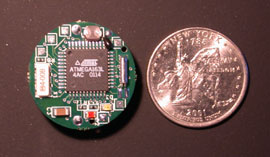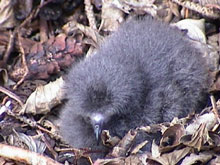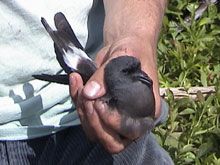Remote Sensing
Air Date: Week of April 25, 2003
Scientists are tracking one of Maine’s most elusive seabirds with a remote sensing system that instantaneously sends data to computers across the country. As Molly Bentley reports, this new technology allows for non-intrusive monitoring of sensitive habitat.
Transcript
CURWOOD: Remote sensing conjures up images of satellites snapping pictures from space. But a new sensor network being used by biologists in Maine has a decidedly earthbound feel. Tiny electronic devices can monitor the activities of creatures with the results relayed to scientists miles away. In this case, researchers are getting valuable data from the nesting grounds of the storm petrel, and hopefully these seabirds never notice. Molly Bentley reports from Great Duck Island off the coast of Maine.
[SOUNDS OF WALKING IN FOREST]
BENTLEY: It's a cool, sunny day and Alan Mainwaring keeps his eye on the ground. He's winding his way among the black spruce trees on the 250-acre Great Duck Island. Mainwaring is a biologist from the Intel Research Laboratory in Berkeley, California, and he's searching for mounds of excavated dirt, the telltale sign of a bird's nest or borough underground.
MAINWARING: There's actually one over here that looks like a pretty good candidate. So what I'm going to do is have a look inside to see if, by chance, there is an animal in it.
BENTLEY: Mainwaring lies on his stomach, his cheek against moss, and reaches into the earth up to his elbow. When he determines that the nest is bird-free, he prepares to deposit a biological sensor in the borough wall.
MAINWARING: This small device I have in my hand is called a mote, otherwise known as a wireless sensor. It has a light sensor, several different types of temperature sensors, and an infrared sensor that's capable of detecting the body heat given off from a bird when it's in its nest. And it has a barometric pressure sensor.
 Mote next to a quarter. (Photo: Intel) Mote next to a quarter. (Photo: Intel) |
BENTLEY: It's the sort of information that a biologist collects in the field, except that a sensor can go where a biologist can't, like into a small hole in the ground. And the sensor monitors continuously. There are 40 or so sensors set up in this forest, each collecting data on a seabird's nest, which is then relayed to the scientist almost instantly.
MAINWARING: We found that even the very, very low-power radios that these devices have are capable of transmitting from inside these burrows and underground, and it's also capable of relaying its readings in almost real time to computers on the Internet. And this is quite revolutionary, because it means the observer can be, really, arbitrarily far away from the environment being monitored. BENTLEY: The storm petrel is a perfect test case for this technology. Biologists know very little about them. Although they're one of the most common seabirds, petrels are rarely seen over land. When they do return to the island, it's at night when they zip into their burrows underground.
|

 A young petrel. (Photo: John Anderson / College of the Atlantic)
A young petrel. (Photo: John Anderson / College of the Atlantic) An adult petrel. (Photo: John Anderson / College of the Atlantic)
An adult petrel. (Photo: John Anderson / College of the Atlantic)




